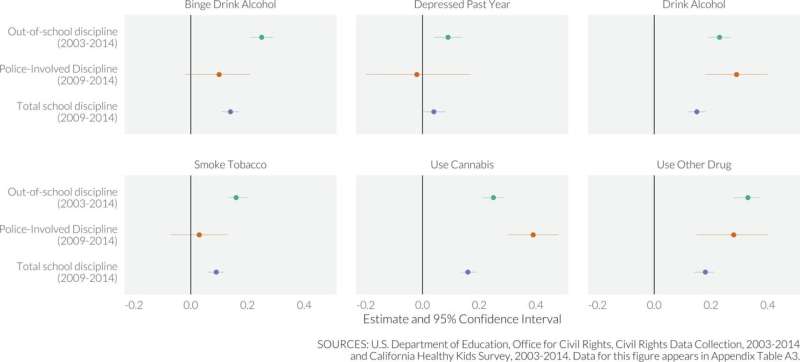Credit: Unsplash/CC0 Public Domain
In new research in the journal Addictive Behaviors, public health researchers find that the prevalence of school discipline and school policing—core elements of the school-to-prison pipeline—predict subsequent school-average levels of substance use and developmental risk.
First author Seth Prins, Ph.D., a researcher at Columbia University Mailman School of Public Health, and co-authors analyzed 11 years of data from 4,800 schools and more than 4,950,000 students in California.
They found that the prevalence of exclusionary school discipline (suspension and expulsion) and school-based police contact predicted higher school levels of binge drinking, drinking, smoking, using cannabis, using other drugs, and violence/harassment. They found also that the prevalence of school discipline also predicted lower levels of reported community support, feeling safe in school, and school support.
"Our findings are surprising to nobody who has been on the front lines of the fight against the mass criminalization of kids, especially in communities that have faced systematic disinvestment in social infrastructure and enormous investments in policing," says Prins, an assistant professor of epidemiology and sociomedical sciences.
Prins and his co-authors argue that school discipline is not developmentally appropriate or responsive (and may be harmful) to adolescent health and developmental need. Furthermore, they say, heavy investments in school securitization and policing divert resources from school and community supports and services that might address the root causes of student disciplinary and health problems.
Results of 18 adjusted multi-level models regressing 6 standardized measures of substance use and depressed feelings on 3 lagged measures of school discipline. Credit: Addictive Behaviors (2022). DOI: 10.1016/j.addbeh.2022.107524
According to a report by the ACLU, more than 10 million students attend schools with police but no counselor, nurse, psychologist, or social worker. And 90 percent of students in public schools experience staffing ratios for those positions that fail to meet professional standards.
According to a report by the Substance Abuse Mental Health Services Administration published in the Journal of School Health in 2019, of the 1.1 million adolescents ages 12-17 who needed substance use treatment, only 6 percent received treatment in a specialty facility, and fewer than 1 in 10 adolescents and young adults with a substance use disorder reported any past-year treatment.
Within this context of low treatment access, a 2019 study found that more than a third of adolescents who do access any mental health treatment access it only at school (they are disproportionately Black and low-income).
The latest study by Prins and colleagues builds on a study they published last year in the Journal of Adolescent Health finding the schools with students who have higher levels of substance use and depressed feelings have a higher prevalence of school discipline and school-based police contact, and that schools with students who felt less safe in school and reported lower school and community support had a higher prevalence of school discipline.
"We need to invest in kids, not cops. We need to prevent and treat substance use problems and the conditions that generate them, not criminalize and punish kids' health," says Prins.
More information: Seth J. Prins et al, Collateral consequences of the school-to-prison pipeline: Adolescent substance use and developmental risk, Addictive Behaviors (2022). DOI: 10.1016/j.addbeh.2022.107524
Mir M. Ali et al, Utilization of Mental Health Services in Educational Setting by Adolescents in the United States, Journal of School Health (2019). DOI: 10.1111/josh.12753
Seth J. Prins et al, School Health Predictors of the School-to-Prison Pipeline: Substance Use and Developmental Risk and Resilience Factors, Journal of Adolescent Health (2021). DOI: 10.1016/j.jadohealth.2021.09.032
Journal information: Journal of Adolescent Health
























